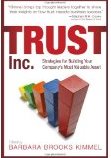Trust, Inc.
Walgreens, the venerable (116 years old, second largest) US drugstore chain, has announced a new tagline as part of a new brand positioning strategy. No longer will it be “At the corner of happy and healthy” – the new mantra is “Trusted Since 1901.”
Well.
I wish Walgreen’s nothing but the best, and don’t doubt their good intentions. Nor are they necessarily wrong on the facts. And, Walgreens is hardly alone in wanting to trumpet their levels of trustworthiness, or their trusted relationships with customers.
However, the use of “trust” in corporate branding is problematic on at least three dimensions. Walgreens provides a good opportunity to explain why.
Cognitive Dissonance
I always tell people not to call themselves a ‘trusted advisor,’ and certainly not to incorporate the phrase into their advertising. It’s like saying “humility is my best quality.”
Trustworthiness is something of a virtue, and calling yourself virtuous just explodes the claim. It’s wonderful when other people use trust to describe you or your relationship with them – as long as it’s them saying it. (“Trust me” may be the two most trust-destroying words you can say).
Calling yourself ‘trusted’ is also different from calling yourself innovative, or respected, or high quality. Walgreens might want to take note that none of the ”Top 10 Most Trusted Brands” brands incorporate trust itself into their taglines.
They might also take note of how it’s worked our for “The Most Trusted Name in News,” whose tagline allows Donald Trump a convenient foil.
Risky Business
Claiming to be trusted is a bit like the Gary Hart strategy – daring the press to find otherwise. It’s like a red flag to a bull.
How many people will manage to dig up the fact that Walgreens made a substantial amount of money and growth during Prohibition by selling (legally) whiskey? Or that the pharmacy business managed to quickly carve out a very liberal interpretation of “medicinal purposes” during that period? Sorry, Walgreens, it’s what you’re setting yourself up for.
History aside, stuff happens. Ask BP about oil spills, or the old Union Carbide about explosions. Or, closer to home, J&J about Tylenol redux. Mis-steps are magnified, and stay in the press longer, for those who claim to be trustworthy in the first place.
Corporations are Not People
This is the biggest one. “Trust” is a word with much contextual nuance of interpretation. But one thing we can say for sure: personal trust is richer and stronger than corporate trust.
We trust people on an emotional level. We trust people based on our views of their intentions, their transparency, and their willingness to trust us.
By contrast, corporations’ intentions are usually very much self-oriented; transparency is little-practiced; and rare is the corporation without legal disclaimers governing their customer relationships. That’s not a criticism (well, it is a little bit); but it’s mainly just stating the difference between protein-based and legally-based entities and the ways we trust them.
Most corporate executives would probably agree with this in the abstract – but they ignore the implications in the particular. If they really believed it, they would be spending money on becoming more trustworthy, rather than on PR campaigns to be seen as more trustworthy, or on reputation management to change perceptions rather than underlying reality.
So What’s a Company to Do?
A company that is serious about being seen as trust-based would start by recognizing – it’s personal.
Trust is not created by spin, advertising, PR, or taglines. It is created by the collective personal behavior over time of corporate employees interacting with customers, suppliers and each other.
This means corporate trust is a culture-and-values issue – not a process-and-marketing issue.
A company that is serious about trust will, among other things:
- figure out how to trust its customers and suppliers, often by taking some form of risk (because trust is reciprocal – we trust those who trust us);
- invest in customer service by focusing on effectiveness, not efficiency; by using ROI, not budget variances, to measure success;
- hire, train for, and role-model best practices for interpersonal trust, including emotional intelligence, strict truth-telling, and vulnerability;
- consistently prioritize long-term, relationship-based behaviors over short-term, self-aggrandizing behaviors, in its compensation and promotion policies;
- focus on ways to establish deeper relationships with stakeholders, rather than focusing on issues like NDAs, non-competes, or arbitration clauses;
- make heroes out of people who model trust-based behavior.
We trust those more who do not protest how much we trust them.

 Do your eyes glaze over at that title? Mine do. I always click on such titles, but am usually disappointed when I get what feels like low-content or high fluff-quotient material. So I set out to tighten up the perspective.
Do your eyes glaze over at that title? Mine do. I always click on such titles, but am usually disappointed when I get what feels like low-content or high fluff-quotient material. So I set out to tighten up the perspective. I recently got to meet
I recently got to meet 

 Noel Burch is credited
Noel Burch is credited Some will recall comic
Some will recall comic  Would you risk your company’s reputation in an attempt to save what amounts to 0.16% of your annual revenue?
Would you risk your company’s reputation in an attempt to save what amounts to 0.16% of your annual revenue?